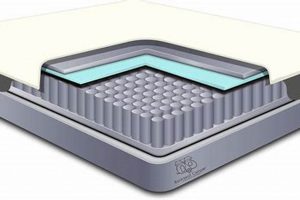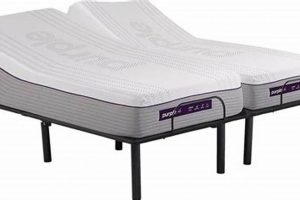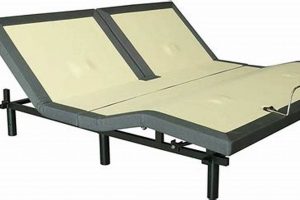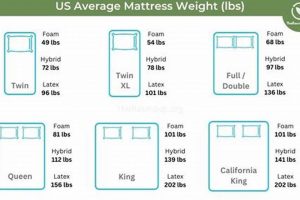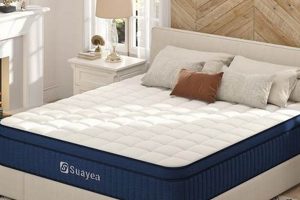The dimensions of a recreational vehicle king size mattress are a crucial specification for ensuring proper fit within the limited space of an RV bedroom. These mattresses typically measure around 72 inches wide and 80 inches long, though variations exist depending on the manufacturer and specific RV model. Confirming the precise dimensions is essential before purchase to avoid issues with installation and functionality.
Accurate sizing is paramount for comfort and efficient use of space. A mattress that is too large can obstruct walkways and storage compartments, while one that is too small may leave uncomfortable gaps. Historically, RV mattresses were often custom-made due to the variations in RV design, but now, standard sizes are increasingly available, simplifying the selection process. Opting for the correct dimensions guarantees a comfortable and practical sleep environment within the confines of the recreational vehicle.
This article will delve into the specifics of selecting appropriately sized mattresses, exploring factors to consider when purchasing a replacement, and highlighting the differences between standard mattress sizes and those tailored for RVs. It will also address common challenges faced when fitting a new mattress into an existing RV space and offer practical solutions.
Guidance for Ensuring Proper Fit
Selecting the correct sleeping surface involves careful consideration of several factors to maximize comfort and space utilization within the recreational vehicle. The following tips offer guidance in navigating the selection process.
Tip 1: Measure the Existing Space Precisely: Accurately measure the existing platform or bed frame within the RV before initiating a purchase. Account for any obstructions or built-in features that might limit the usable area. Inaccurate measurements can lead to significant fitment issues.
Tip 2: Consult the RV Manufacturer’s Specifications: Whenever possible, consult the manufacturer’s documentation for recommended mattress dimensions. This information can provide a baseline and prevent compatibility problems. Deviation from these recommendations should only occur after thorough assessment.
Tip 3: Consider Mattress Thickness: Mattress thickness impacts headroom and ease of movement within the RV. Account for the combined height of the mattress and any existing bedding to ensure sufficient clearance, particularly in confined spaces.
Tip 4: Account for Wall Obstructions and Cabinetry: Inspect the area around the sleeping platform for potential obstructions such as walls, cabinets, or storage compartments. Factor these elements into the measurements to avoid interference with the mattress’s placement or accessibility to storage areas.
Tip 5: Prioritize Comfort and Support Requirements: While dimensions are critical, ensure that the chosen mattress offers adequate comfort and support. Compromising on these aspects for the sake of size can lead to discomfort and negatively impact sleep quality. Explore options that provide both proper fit and ergonomic support.
Tip 6: Factor in Bedding and Linens: When determining the ideal size, remember to account for the additional space required for bedding and linens. Overhang or tight fits can impact the overall comfort and ease of making the bed.
Adhering to these guidelines will assist in selecting a recreational vehicle king size mattress that optimizes both space and comfort, ultimately enhancing the travel experience.
The subsequent sections will address the practical aspects of installation and long-term maintenance of these specialized mattresses.
1. Width (Inches)
The width, measured in inches, constitutes a primary dimensional component of recreational vehicle king size mattress specifications. It directly impacts the suitability of the mattress for installation within a designated sleeping area. An inaccurate width dimension can result in either an inability to install the mattress or inefficient use of the available space. For example, if the designated RV bed platform measures 72 inches wide, a mattress exceeding this width cannot be accommodated without modification of the existing structure, which may not be feasible. Conversely, a significantly narrower mattress would leave an undesirable gap, reducing usable sleeping area and potentially causing discomfort.
Furthermore, the width influences sleeping comfort, particularly for multiple occupants. A reduced width may compromise individual sleeping space, leading to disturbances during the night. In practical applications, the selected width must balance occupant comfort with spatial constraints. Certain RV manufacturers offer “short king” variations to address space limitations, reducing the width while maintaining a similar length to standard king mattresses. The practical significance of understanding this dimension lies in enabling informed purchasing decisions that prioritize both comfort and efficient space utilization.
In conclusion, the accurate measurement and consideration of width, expressed in inches, is a critical factor in selecting an appropriately sized recreational vehicle king mattress. Incorrect width selection directly impacts installation feasibility, sleeping comfort, and efficient use of space within the confines of a recreational vehicle. Navigating width requirements can be aided through consultation with RV manufacturers and detailed measurement procedures to ensure a suitable choice.
2. Length (Inches)
The length, expressed in inches, constitutes another fundamental dimensional characteristic of a recreational vehicle king size mattress. Its significance stems from the direct correlation to occupant comfort and the efficient utilization of space within the RV’s sleeping area. A discrepancy between the mattress length and the available platform length can lead to significant functional issues. A mattress that exceeds the platform length may overhang, creating an unstable sleeping surface and potential damage to both the mattress and surrounding structures. Conversely, a mattress that is too short results in unused space, reducing the overall sleeping area and potentially causing discomfort or safety issues for taller individuals.
For example, an RV king mattress advertised as 80 inches long must be accurately measured to verify this dimension. If the bed frame within the RV is only 78 inches, the mattress will not fit properly without modifications to the frame. This can necessitate costly alterations or the selection of a smaller mattress size. Custom RV mattresses are often selected due to the unique sleeping arrangement. RVs often feature shortened mattresses to accommodate limited dimensions. For these situations, it is crucial to carefully examine whether the custom dimensions of the recreational vehicle king mattress still meet comfort requirements.
In summary, the accurate specification a
nd verification of length, in inches, is indispensable in ensuring the proper fit of an RV king mattress. Mismatched length dimensions can lead to discomfort, instability, and inefficient use of the available space, ultimately detracting from the travel experience. Selecting an RV king size mattress must include an understanding of the importance of proper length dimensions to ensure it meets comfort requirements.
3. Thickness (Inches)
Thickness, quantified in inches, represents a significant dimension within the broader scope of RV king mattress dimensions. It directly influences comfort, support, and headroom, all crucial factors within the confined space of a recreational vehicle. The thickness of a mattress contributes to the overall support provided, with thicker mattresses generally offering greater cushioning and pressure relief. However, increased thickness can reduce the available headroom, potentially impacting ease of movement and the overall sense of spaciousness within the RV. For instance, a mattress exceeding 12 inches in thickness may prove unsuitable in RVs with low ceilings, while a thinner mattress, below 6 inches, might compromise on comfort and support for some individuals.
Thickness also affects the storage space above or below the sleeping platform. Many RV designs incorporate storage compartments accessible from the top, requiring consideration of the mattress thickness to maintain accessibility. Furthermore, mattress thickness can influence the choice of bedding and linens. Thicker mattresses necessitate deeper pocket sheets to ensure a secure and proper fit. The relationship between thickness and weight is also important; thicker mattresses generally weigh more, which can impact the RV’s overall weight distribution and fuel efficiency. Considering the effect of mattress thickness is crucial when determining the dimensions of the sleeping area in an RV.
In summary, thickness, measured in inches, represents a vital dimensional attribute of RV king mattresses. Its selection requires a careful balance between comfort, support, headroom, and storage considerations. The ideal thickness varies depending on individual preferences, RV design, and usage patterns. Awareness of its implications ensures a well-informed purchasing decision, optimizing the sleeping experience within the constraints of a recreational vehicle. Therefore the RV dimensions should be understood fully before RV king size mattress is purchased.
4. Weight (Pounds)
Weight, measured in pounds, represents a critical, yet often overlooked, dimensional attribute intimately connected to RV king mattress measurements. It is not a physical measurement in the same sense as width, length, or thickness; instead, it is a consequence of those dimensions and the materials used in the mattress’s construction. The weight directly impacts the RV’s overall load capacity, fuel efficiency, and handling characteristics. Exceeding the RV’s specified weight limits can compromise safety, reduce maneuverability, and potentially cause mechanical damage. For instance, if an RV is rated to carry a maximum load of 2,000 pounds, and a new, oversized, high-density foam mattress adds an unexpected 150 pounds, the RV’s available payload is diminished by that amount, potentially pushing the vehicle beyond its safe operating limits.
The relationship between weight and the other dimensions is significant. A thicker mattress, or one constructed with denser materials like memory foam or latex, will invariably weigh more than a thinner mattress made with lighter materials. While comfort and support are essential, selecting a mattress solely based on these criteria without considering its weight can lead to practical challenges. The distribution of weight within the RV is also relevant. Concentrating excessive weight in one area, such as the rear bedroom, can negatively impact the vehicle’s balance and stability. Practical applications include calculating the weight of all items being added to the RV, including the mattress, and comparing that total to the RV’s specified load capacity. Regular weighing of the RV at a certified scale can also provide an accurate assessment of its current weight.
In summary, the weight of an RV king mattress, measured in pounds, is inextricably linked to its dimensions and material composition. Its impact extends beyond mere convenience, directly affecting the RV’s safety, performance, and fuel economy. A thorough understanding of this relationship, coupled with careful weight management practices, is crucial for responsible RV ownership and travel. Ignoring this aspect may lead to significant safety or mechanical issues, underlining the importance of considering weight as an integral part of the overall mattress selection process for RVs.
5. Corner Radius
The corner radius, while seemingly a minor element, plays a critical role in optimizing the fit and functionality of an RV king mattress within the confined spaces of a recreational vehicle. The term refers to the curvature of the mattress corners, rather than sharp, 90-degree angles. This design element is directly influenced by and, in turn, influences overall RV king mattress measurements. A sharper corner radius, approaching a right angle, can create fitting issues within RVs where the bed frame or surrounding structures incorporate rounded corners. Conversely, a more pronounced corner radius, such as a significantly rounded corner, might result in unused space and a less secure fit, allowing the mattress to shift during travel. The relationship between the mattress’s corner radius and the RV’s interior architecture is thus a critical determinant of its practical suitability.
The practical significance of understanding corner radius lies in its direct impact on installation and space utilization. For example, consider an RV with a bed frame featuring a pre-existing corner radius of 4 inches. Selecting a mattress with sharp, unrounded corners will necessitate either modification of the bed frame or forcing the mattress into a space it is not designed to occupy, potentially damaging both the mattress and the frame. Alternatively, a mattress with a corner radius significantly exceeding the frame’s radius could lead to gaps and instability. Manufacturers often specify corner radius measurements in their product specifications to facilitate proper matching. It is recommended to obtain precise measurements of the existing bed frame’s corner radius before purchasing a new RV king mattress. Accurate measurement can also benefit a new RV mattress when the sleeping area is in a corner of the vehicle.
In summary, the corner radius forms an integral, though often overlooked, component of RV king mattress measurements. Its proper consideration ensures a secure, efficient, and aesthetically pleasing fit within the unique constraints of RV interiors. Neglecting this aspect can lead to installation difficulties, wasted space, and potential damage, underscoring the importance of matching the mattress’s corner radius to the RV’s existing bed frame or surrounding architectural features. Consideration of radius helps with a comfortable and appropriate fit, especially when corners are involved.
6. Compressed Height
Compressed height, in relation to RV king mattress measurements, refers to the mattress’s vertical dimension when subjected to a specific load, simulating the pressure exerted by a sleeping individual. This metric is a critical, albeit often overlooked, aspect of RV mattress selection, as it directly impacts headroom, comfort, and the overall usability of the sleeping space within a recreational vehicle. The uncompressed thickness of a mattress can be misleading, especially with materials like memory foam or latex that compress significantly under weight. For example, a mattress advertised as 10 inches thick may compress to 6 inches or less when occupied, affecting the available headroom and potentially altering the intended level of support. Understanding this compression is therefore essential for ensuring a comfortable and functional sleeping environment, particularly within the typically confined spaces of an RV.
The compressed height dictates how much space remains above the mattress for comfortable movement and sitting up in bed. In RVs with overhead storage or low ceilings, this dimension becomes even more crucial. A mattress that compresses too little may leave insufficient headroom, leading to discomfort and potential inconvenience. Conversely, excessive compression can reduce support and potentially cause the sleeper to sink too deeply into the mattress, impacting spinal alignment and sleep quality. Furthermore, compressed height influences the effectiveness of ventilation and moisture management within the mattress. A heavily compressed mattress may restrict airflow, increasing the risk of moisture buildup and affecting overall hygiene. An accurate compressed height can greatly increase the comfort of a sleeping experience.
In summary, the compressed height is a vital component of RV king mattress measurements, significantly impacting comfort, headroom, and support. Awareness of this metric enables informed decision-making, ensuring the selected mattress meets both dimensional constraints and the specific comfort requirements of the RV’s occupants. Neglecting this factor can lead to unsatisfactory sleeping experiences and compromised usability of the RV’s sleeping area. Therefore, manufacturers should provide, and consumers should seek, information about both uncompressed and compressed height values to make well-informed purchasing decisions.
7. Edge Support
Edge support, as a design element of an RV king mattress, is inextricably linked to its overall measurements and significantly impacts functionality. It refers to the reinforcement along the perimeter of the mattress, designed to prevent sagging or compression when weight is applied near the edges. In the context of RV king mattress measurements, edge support influences the usable sleeping surface; a mattress with inadequate edge support effectively reduces the available width and length, as sleepers tend to avoid the unstable edges. This is particularly crucial in the limited space of an RV, where maximizing every inch of sleeping area is paramount. The type and quality of edge support will invariably influence how much of the advertised mattress dimensions are truly usable, thereby impacting comfort and practicality. A mattress may claim to be 72 inches wide, but if the outer 6 inches on each side collapse easily, the effective sleeping width is significantly reduced.
The type of edge support employed directly affects the precise dimensions and construction techniques used in manufacturing an RV king mattress. For example, some mattresses utilize high-density foam encasements, while others incorporate steel springs or reinforced edge coils. These structural additions alter the overall dimensions and weight distribution of the mattress. Additionally, robust edge support can prolong the lifespan of the mattress by preventing premature wear and tear along the perimeter. Consider a scenario where two individuals consistently sleep near the edges of an RV king mattress lacking adequate edge support. Over time, the edges will degrade, causing the mattress to deform and leading to uneven weight distribution and discomfort. In contrast, a mattress with reinforced edges will maintain its shape and provide consistent support across the entire sleeping surface, preserving the advertised dimensions and ensuring long-term comfort.
In conclusion, edge support is not merely a supplementary feature but rather an integral component of RV king mattress measurements that significantly influences the usable sleeping area, durability, and overall comfort. Its effectiveness should be carefully considered when selecting a mattress to ensure that the advertised dimensions translate into a practical and comfortable sleeping experience within the confines of a recreational vehicle. The choice of edge support technology will have a large effect on mattress usage and expected lifespan.
Frequently Asked Questions
This section addresses common inquiries regarding the specific dimensions and considerations relevant to recreational vehicle king-size mattresses.
Question 1: What are the standard dimensions of an RV king mattress?
While similar in name to a standard king mattress, an RV king typically measures around 72 inches wide by 80 inches long. However, variations exist depending on the RV manufacturer and specific model. Verification of precise dimensions is crucial before purchase.
Question 2: Why are RV king mattresses different sizes than standard king mattresses?
The dimensional differences are primarily dictated by the spatial constraints within recreational vehicles. RVs generally have limited space, necessitating mattresses tailored to fit smaller, often non-standard, sleeping areas.
Question 3: How does mattress thickness impact the selection of an RV king mattress?
Thickness directly affects headroom and ease of movement within the RV. A mattress that is too thick can compromise headroom, while one that is too thin may lack adequate support. The selection process should carefully balance these factors.
Question 4: What role does weight play when considering RV king mattress dimensions?
The weight of the mattress contributes to the overall load capacity of the RV. Exceeding the RV’s weight limits can negatively impact fuel efficiency and handling. Lighter materials are generally preferred for RV mattresses.
Question 5: Why is it important to consider the corner radius of an RV king mattress?
The corner radius, or curvature, of the mattress corners affects the fit within the RV’s bed frame or surrounding structures. Sharp corners may not fit properly, while excessively rounded corners can lead to unused space.
Question 6: How does compressed height factor into RV king mattress dimensions?
Compressed height refers to the mattress’s thickness when subjected to weight. This dimension affects headroom and support, particularly with materials like memory foam that compress significantly. Consideration of both uncompressed and compressed height is recommended.
Careful attention to these dimensions is essential for selecting an RV king mattress that optimizes both comfort and space utilization.
The subsequent section will provide guidance on selecting an RV king size mattress.
Conclusion
This article has provided a comprehensive exploration of RV king mattress measurements, emphasizing the crit
ical dimensions that influence comfort, space utilization, and overall functionality within recreational vehicles. Proper assessment of width, length, thickness, weight, corner radius, compressed height, and edge support is essential for making informed purchasing decisions.
Selecting the appropriate mattress dimensions demands careful attention to detail and a thorough understanding of the RV’s spatial constraints. Neglecting these measurements can lead to discomfort, safety issues, and inefficient use of valuable space. The careful consideration of dimensions ultimately ensures a secure and comfortable sleeping arrangement, and enhances the travel experience. Potential buyers are encouraged to prioritize accurate measurement and to seek manufacturer specifications before making a selection.



